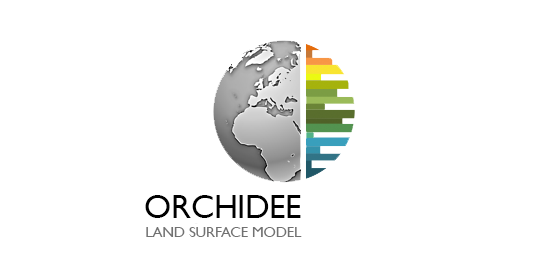| Version 132 (modified by msaad, 6 years ago) (diff) |
|---|
= Evaluation of ORCHIDEE for N coumpounds emissions =
Working group
Mohamed Saad, Nicolas Vuichard, Juliette Lathiere, Didier Hauglustaine
Planned work
1-Perform a set of simulations with the ORCHIDEE model to quantify the fluxes of nitrogen compounds (NH3,NOx,N2O) emitted by the soil.
2-Evaluate simulated emissions at national, continental and global scales by comparing them to emissions by other methods such as inventories (eg: EDGAR).
3-Develop the coupling between ORCHIDEE and INCA models in terms of downward (deposition)and upward(emissions) N fluxes.
Team meeting: 06/03/2019
Define the work steps:
- Read some bibliographical references related to the subject of work.
- Start by seeing outputs of a simulation performed by the ORCHIDEE model as part of NMIP (Tian et al., 2018a, b).
- look at the variable NH3_EMISSION which gives the emissions per m2 of each type of vegetation. It is an information to combine with the file VEGET_MAX which gives us the fraction of mesh occupied by each type of vegetation.
- See the outputs of the NH3 simulations made by INCA to compare them with those of ORCHIDEE.
Team meeting: 13/03/2019
Evaluate the outputs of the NH3 (monthly, seasonal (averaged, maximum, minimum)) simulations of ORCHIDEE (2016) and INCA.
Note: In this section the maps of the NH3 emissions simulated by the ORCHIDEE model are not corrected by the CONTFRAC.
 January January |  February February |  March March
|
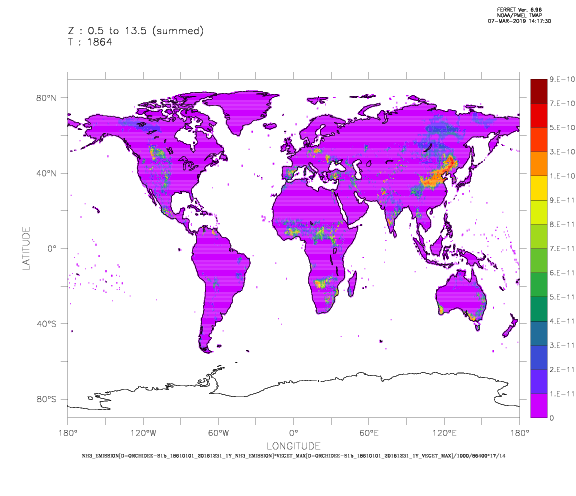 April April |  May May |  June June
|
 July July |  August August |  September September
|
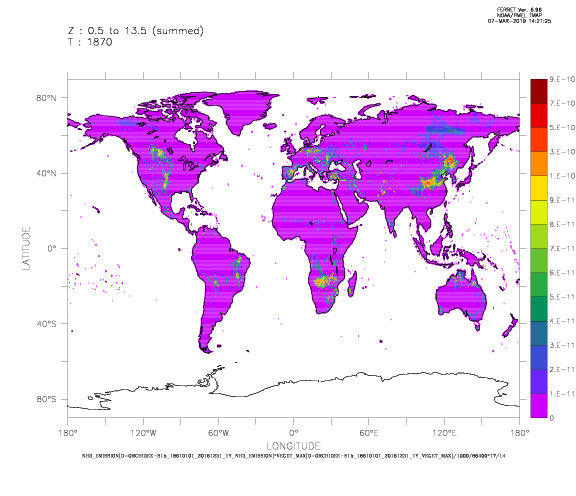 October October |  November November |  December December
|
Monthly averaged emissions of NH3 simulated by ORCHIDEE model for 2016 (NH3_EMISSION).
 Winter Winter |  Spring Spring
|
 Summer Summer |  Autumn Autumn
|
Seasonal Averaged emissions of NH3 simulated by ORCHIDEE model of 2016 (NH3_EMISSION).
 Winter Winter |  Summer Summer |  Autumn Autumn
|
Maximum emissions of NH3 simulated by ORCHIDEE model for 2016 (NH3_EMISSION).
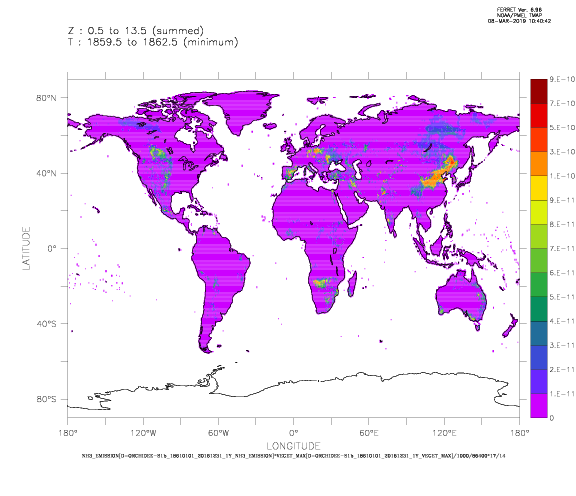 Winter Winter | 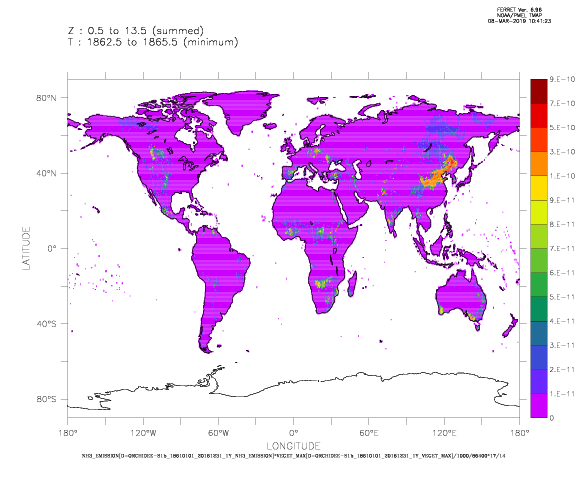 Spring Spring
|
 Summer Summer |  Automn Automn
|
Minimum emissions of NH3 simulated by ORCHIDEE model for 2016 (NH3_EMISSION).
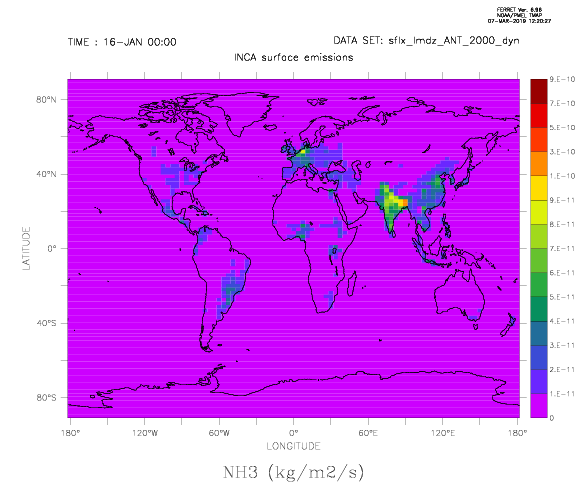 January January |  February February |  March March
|
 April April |  May May |  June June
|
 July July |  August August |  September September
|
 October October |  November November |  December December
|
Monthly averaged emissions of NH3 of INCA (FLX_NH3)
 Spring Spring |  Summer Summer |  Autumn Autumn
|
Seasonal averaged emissions of NH3 simulated by INCA (FLX_NH3).
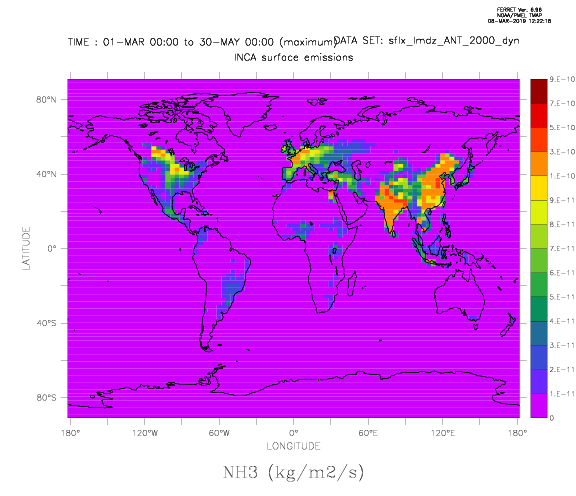 Spring Spring |  Summer Summer |  Autumn Autumn
|
Maximum emissions of NH3 simulated by INCA (FLX_NH3).
 Spring Spring | 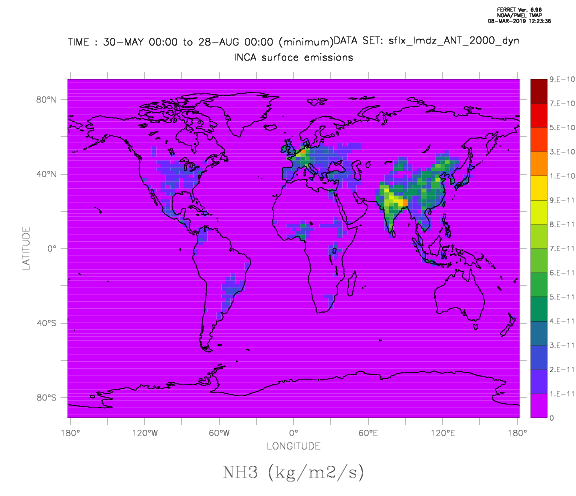 Summer Summer | 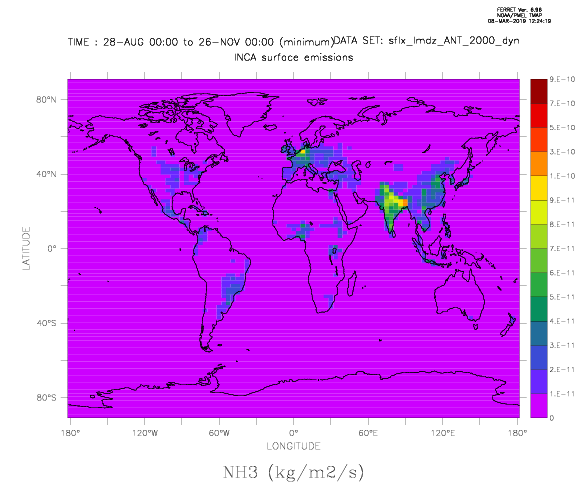 Autumn Autumn
| |
Minimum emissions of NH3 simulated by INCA (FLX_NH3).
What is the temporal variability of the emissions of NH3 mainly for the months of May and September?
Recommendations
- include the global balances of the emissions of NH3 for ORCHIDEE and INCA for the period of 2000-2014.
Team meeting: 20/03/2019

|
Global balances of the emissions of NH3 for ORCHIDEE (black) and INCA (red) for the period of 2000-2014.
What is the origin of this difference between the global balances of the emissions of NH3.
Recommendations
- Focus on NH3 emissions from the agricultural sector for INCA.
- See references and inventories.
- Compare the emissions of NH3 for INCA with those of the EDGAR inventory.
Team meeting: 27/03/2019
| EDGAR | 4B_ Manure Management: cattle, buffalo, sheep, goats, camels and llamas , horses, mules , asses, swine, poultry | 4C+4D_ Agricultural Soils: rice cultivation, N- crops, organic and inorganic fertilizers, biological Nitrogen fixation, crop residues | 4F_Field burning of agricultural Residues: cereals, pulse, tuber and root, sugar cane, other | CEDS | 3B_ Manure Management: manure management of cattle, buffalo, sheep, geese,goats, camels, horses, asses, swine, chickens, ducks, turkeys | 3D_ Soils Emissions: rice cultivation,nitrogen fertilizers, animal waste as fertilizer, N-fixing crops, crop residues, Histosols, buffalo in pasture, cattle in pasture, chickens in pasture, ducks in pasture, goats in pasture, horses in pasture, mules and asses in pasture, pigs in pasture, sheep in pasture, turkeys in pasture, Agricultural soils, liming |
Agriculture sector sources for EDGAR and INCA.
* For EDGAR inventory, sector names were derived from Intergovernmental Panel on Climate Change (IPCC) reporting categories under the 1996 guidelines. (https://www.ipcc-nggip.iges.or.jp/public/gl/guidelin/ch1ri.pdf)
 2000 2000 |  2001 2001 |  2002 2002
|
 2003 2003 |  2004 2004 |  2005 2005
|
 2006 2006 |  2007 2007 |  2008 2008
|
 2009 2009 | 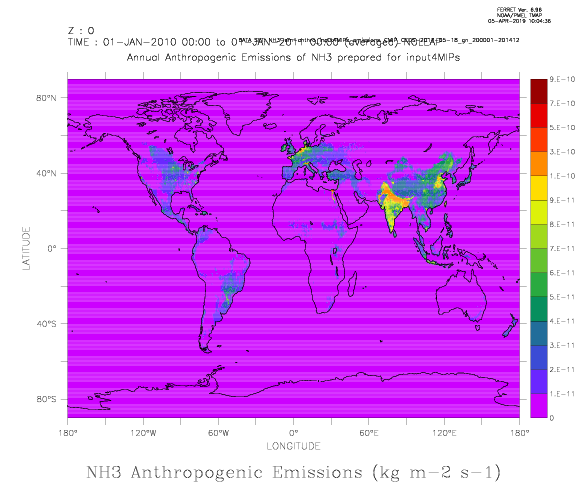 2010 2010 |  2011 2011
|
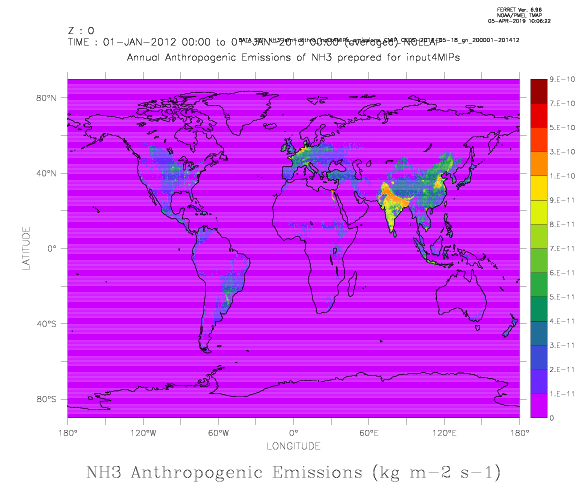 2012 2012
|
Annual emissions of NH3 for CEDS from the agricultural sector from 2000 to 2012 (NH3_EM_ANTHRO).
 2000 2000 |  2001 2001 |  2002 2002
| |
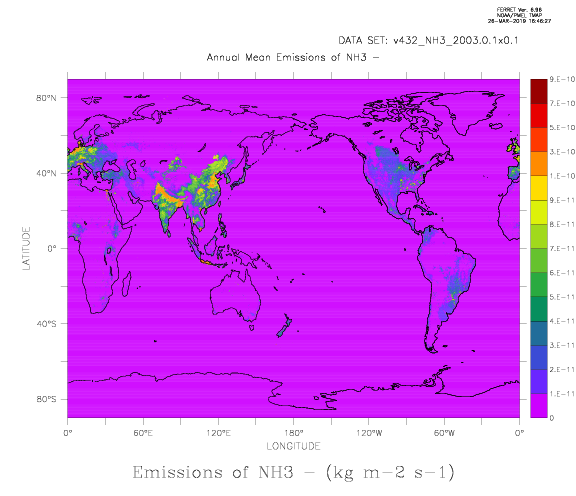 2003 2003 |  2004 2004 | 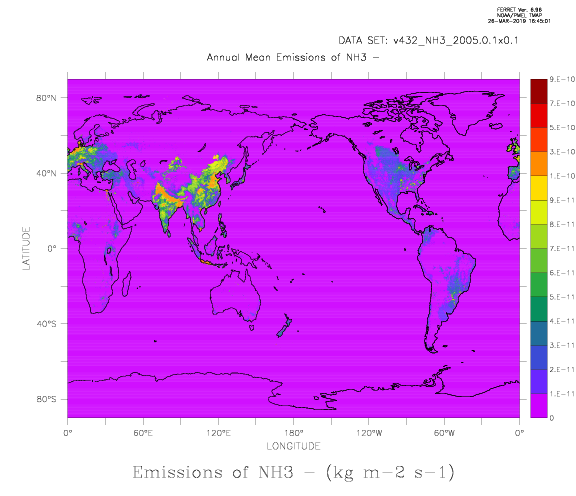 2005 2005
| |
 2006 2006 |  2007 2007 |  2008 2008
| |
 2009 2009 | 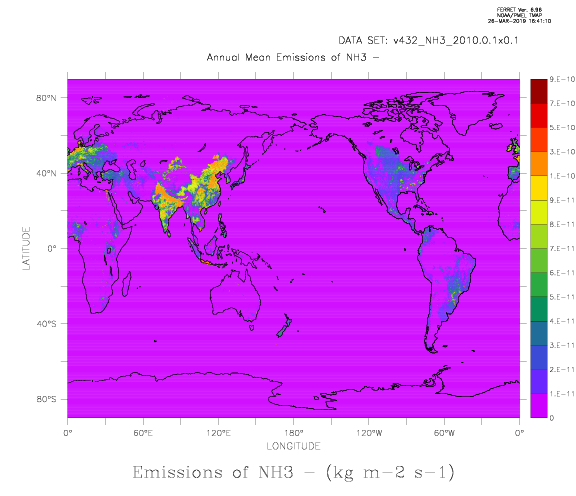 2010 2010 |  2011 2011 | | |
 2012 2012
|
Annual emissions of NH3 for EDGAR inventory from 2000 to 2012 (EDGAR INVENTORY).
What are the different sources that contribute to emissions from the agricultural sector for EDGAR inventory.
Recommendations
- Focus on NH3 emissions from the agricultural sector for EDGAR inventory.
Team meeting: 03/04/2019
The important sources for which the EDGAR inventory accounts for the agricultural sector are:
- Agricultural Soil: 4C + 4D
- Manure Management: 4B
- Agricultural Waste BURNING: 4F
 2000 2000 |  2001 2001 |  2002 2002
|
 2003 2003 |  2004 2004 |  2005 2005
|
 2006 2006 | 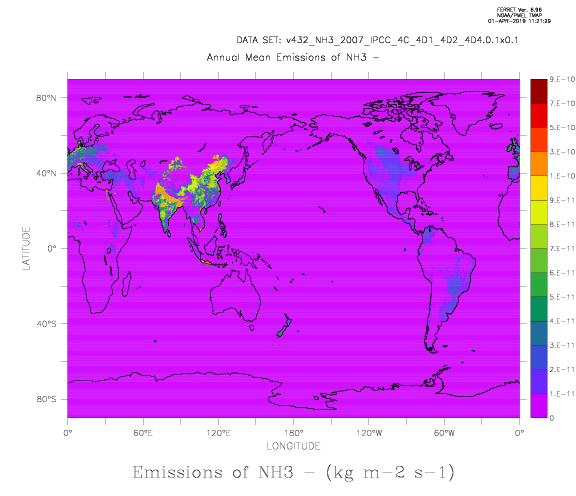 2007 2007 |  2008 2008
|
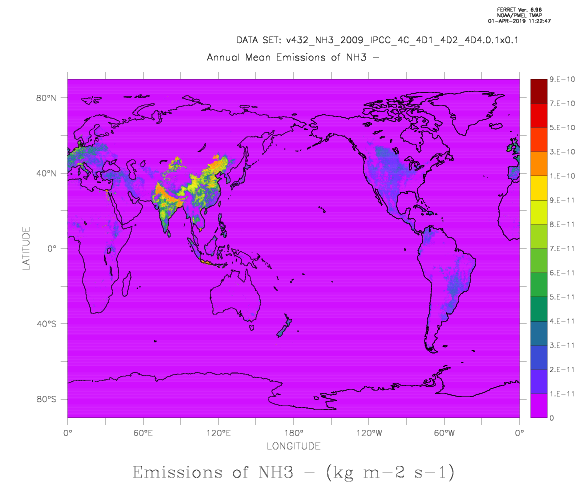 2009 2009 | 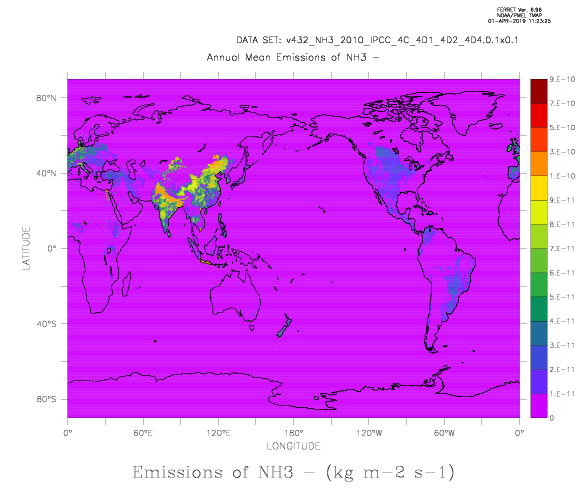 2010 2010 | 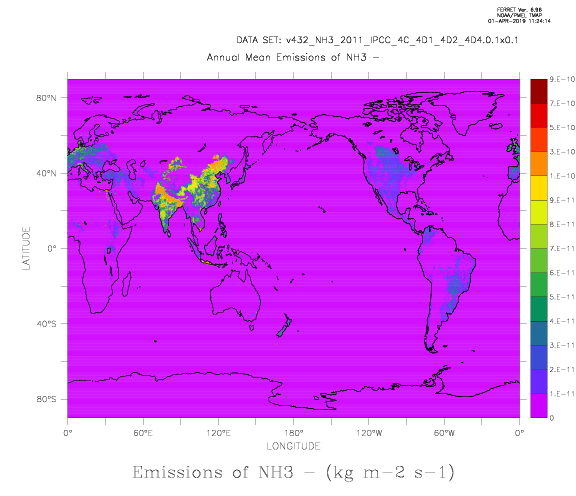 2011 2011
|
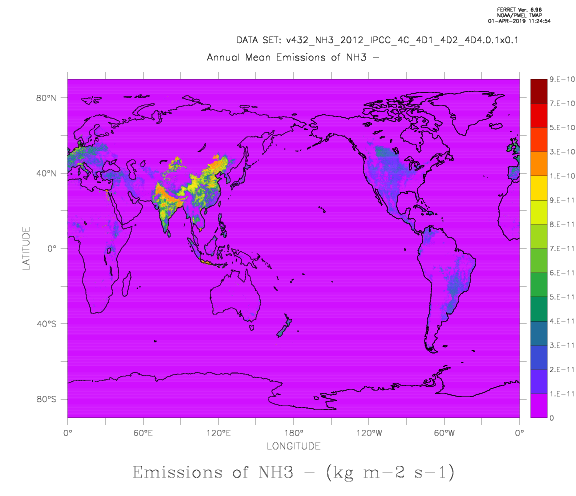 2012 2012
|
Annual emissions of NH3 from agricultural soil for EDGAR inventory from 2000 to 2012.
 2000 2000 |  2001 2001 |  2002 2002
|
 2003 2003 |  2004 2004 |  2005 2005
|
 2006 2006 |  2007 2007 | 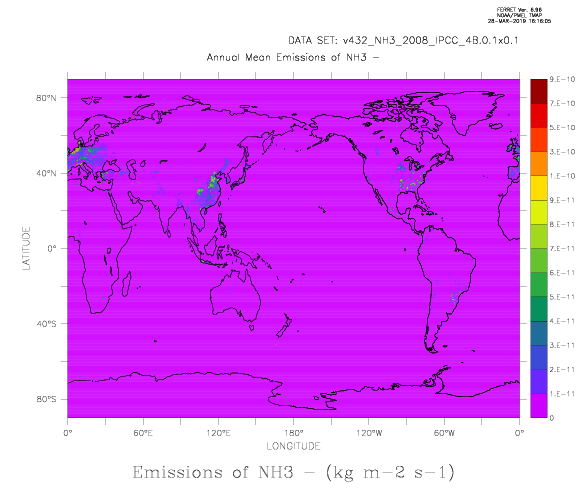 2008 2008
|
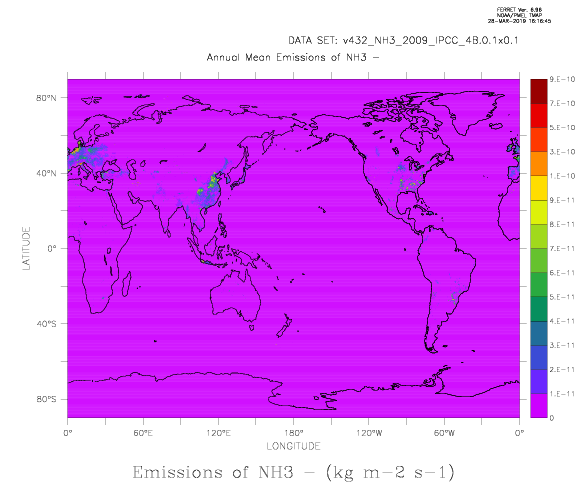 2009 2009 |  2010 2010 |  2011 2011
|
 2012 2012
|
Annual emissions of NH3 from manure management for EDGAR inventory from 2000 to 2012.
what is the monthly variability of NH3 emissions from agricultural soil and manure management for EDGAR inventory.
The monthly data available for agricultural soil and manure management are for the year 2010.
 January January |  February February |  March March
|
 April April |  May May |  June June
|
 July July |  August August |  September September
|
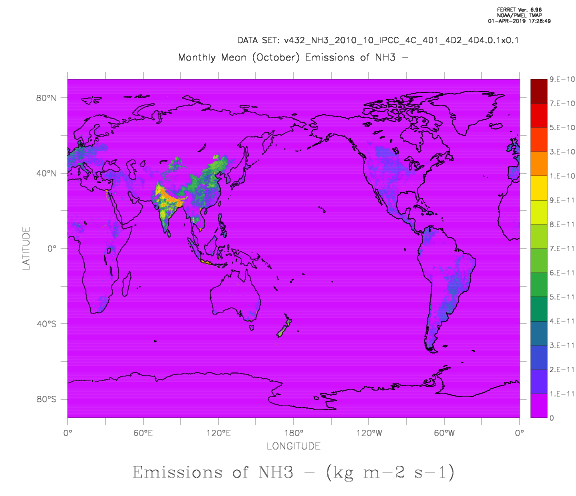 October October |  November November |  December December
|
Monthly change in NH3 emissions from agricultural soil for the EDGAR inventory for 2010.
 January January |  February February | 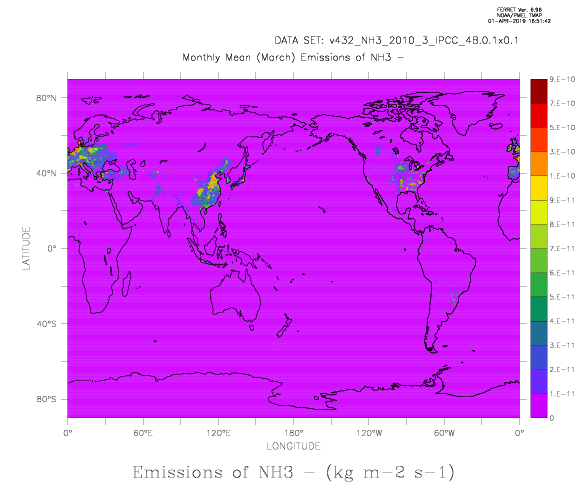 March March
|
 April April |  May May |  June June
|
 July July |  August August |  September September
|
 October October |  November November | 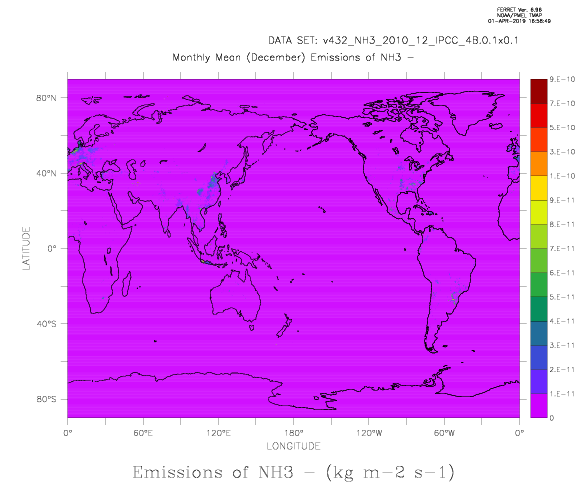 December December
|
Monthly change in NH3 emissions from manure management for the EDGAR inventory for 2010.

|
Recommendations
- Monthly reports of NH3 emissions for the various sources involved in the agriculture sector of the EDGAR inventory for the year 2010.
Team meeting: 17/04/2019
 90S_90N 90S_90N |  90S_30S 90S_30S
|
 30S_30N 30S_30N |  30N_90N 30N_90N
|
Monthly reports of NH3 emissions for the various sources involved in the agriculture sector of the EDGAR inventory for the year 2010: Agricultural soil (black), Manure Management (green) and Agricultural waste Burning (red).
Recommendations
- Add monthly reports of NH3 emissions for the various sources involved in the agriculture sector of the EDGAR inventory for the year 2010 for 0:30N and 30S:0
- include the global balances of the emissions of NH3 for CEDS,EDGAR and ORCHIDEE for the period of 1970-2014.
Note: From this section the maps of the NH3 emissions simulated by the ORCHIDEE model will be corrected by the CONTFRAC.
 30S_0 30S_0 |  0_30N 0_30N
|
Monthly reports of NH3 emissions for the various sources involved in the agriculture sector of the EDGAR inventory for the year 2010: Agricultural soil (black), Manure Management (red) and Agricultural waste Burning (green).
 90S_90N 90S_90N |  90S_30S 90S_30S
|
 30S_30N 30S_30N |  30N_90N 30N_90N
|
 30S_0 30S_0 |  0_30N 0_30N
|
Monthly reports of NH3 emissions for the various sources involved in the agriculture sector of the EDGAR inventory for the year 2010: Agricultural soil (black), Manure Management (green) and Agricultural waste Burning (red).

|
global balances of the emissions of NH3 for CEDS,EDGAR and ORCHIDEE for the period of 1970-2014.
References
1- Hoesly et al.,2018: Historical (1750–2014) anthropogenic emissions of reactive gasesand aerosols from the Community Emissions Data System (CEDS).
2- Riddick et al.,2016: Estimate of changes in agricultural terrestrial nitrogen pathwaysand ammonia emissions from 1850 to present in theCommunity Earth System Model.
3- Crippa et al.,2018: Gridded emissions of air pollutants for the period 1970–2012 within EDGAR v4.3.2.
4- Janssens-Maenhou et al.,2017: EDGAR v4.3.2 Global Atlas of the three major Greenhouse Gas Emissions for the period 1970–2012.
5- Janssens-Maenhout et al.,2015: HTAP_v2.2: a mosaic of regional and global emission grid maps for 2008 and 2010 to study hemispheric transport of air pollution.
Attachments (444)
- NH3_EMISSION_JANVIER.png (104.5 KB) - added by msaad 6 years ago.
- NH3_EMISSION_FEVRIER.png (104.1 KB) - added by msaad 6 years ago.
- NH3_EMISSION_MARS.png (103.9 KB) - added by msaad 6 years ago.
- NH3_EMISSION_AVRIL.png (102.3 KB) - added by msaad 6 years ago.
- NH3_EMISSION_MAI.png (100.5 KB) - added by msaad 6 years ago.
- NH3_EMISSION_JUIN.png (99.4 KB) - added by msaad 6 years ago.
- NH3_EMISSION_JUILLET.png (99.8 KB) - added by msaad 6 years ago.
- NH3_EMISSION_AOUT.png (100.8 KB) - added by msaad 6 years ago.
- NH3_EMISSION_SEPTEMBRE.png (101.0 KB) - added by msaad 6 years ago.
- NH3_EMISSION_OCTOBRE.png (101.4 KB) - added by msaad 6 years ago.
- NH3_EMISSION_NOVEMBRE.png (101.9 KB) - added by msaad 6 years ago.
- NH3_EMISSION_DECEMBRE.png (102.6 KB) - added by msaad 6 years ago.
- NH3_EMISSION_HIVER.png (105.5 KB) - added by msaad 6 years ago.
- NH3_EMISSION_HIVER_MAX.png (108.9 KB) - added by msaad 6 years ago.
- NH3_EMISSION_HIVER_MIN.png (101.0 KB) - added by msaad 6 years ago.
- NH3_EMISSION_PRINTEMPS_MIN.png (98.2 KB) - added by msaad 6 years ago.
- NH3_EMISSION_ETE.png (101.5 KB) - added by msaad 6 years ago.
- NH3_EMISSION_ETE_MAX.png (106.0 KB) - added by msaad 6 years ago.
- NH3_EMISSION_ETE_MIN.png (94.5 KB) - added by msaad 6 years ago.
- NH3_EMISSION_AUTOMNE.png (102.4 KB) - added by msaad 6 years ago.
- NH3_EMISSION_AUTOMNE_MAX.png (105.7 KB) - added by msaad 6 years ago.
- NH3_EMISSION_AUTOMNE_MIN.png (98.3 KB) - added by msaad 6 years ago.
- NH3_EMISSION_PRINTEMPS.png (102.9 KB) - added by msaad 6 years ago.
- FLX_NH3_JANVIER.png (59.6 KB) - added by msaad 6 years ago.
- FLX_NH3_FEVRIER.png (60.1 KB) - added by msaad 6 years ago.
- FLX_NH3_MARS.png (60.4 KB) - added by msaad 6 years ago.
- FLX_NH3_AVRIL.png (62.4 KB) - added by msaad 6 years ago.
- FLX_NH3_MAI.png (64.3 KB) - added by msaad 6 years ago.
- FLX_NH3_JUIN.png (60.9 KB) - added by msaad 6 years ago.
- FLX_NH3_JUILLET.png (60.8 KB) - added by msaad 6 years ago.
- FLX_NH3_AOUT.png (61.1 KB) - added by msaad 6 years ago.
- FLX_NH3_SEPTEMBRE.png (63.1 KB) - added by msaad 6 years ago.
- FLX_NH3_OCTOBRE.png (61.7 KB) - added by msaad 6 years ago.
- FLX_NH3_NOVEMBRE.png (59.6 KB) - added by msaad 6 years ago.
- FLX_NH3_DECEMBRE.png (59.6 KB) - added by msaad 6 years ago.
- FLX_NH3_ETE.png (61.7 KB) - added by msaad 6 years ago.
- FLX_NH3_ETE_MAX.png (61.9 KB) - added by msaad 6 years ago.
- FLX_NH3_ETE_MIN.png (61.5 KB) - added by msaad 6 years ago.
- FLX_NH3_PRINTEMPS.png (63.7 KB) - added by msaad 6 years ago.
- FLX_NH3_PRINTEMPS_MAX.png (65.1 KB) - added by msaad 6 years ago.
- FLX_NH3_PRINTEMPS_MIN.png (60.8 KB) - added by msaad 6 years ago.
- FLX_NH3_AUTOMNE.png (62.6 KB) - added by msaad 6 years ago.
- FLX_NH3_AUTOMNE_MAX.png (65.0 KB) - added by msaad 6 years ago.
- FLX_NH3_AUTOMNE_MIN.png (60.2 KB) - added by msaad 6 years ago.
- bilan_globe_2000_2014_ceds_orc.gif (5.8 KB) - added by msaad 6 years ago.
- NH3_EM_ANTHRO_2000_Moyenne.png (92.6 KB) - added by msaad 6 years ago.
- NH3_EM_ANTHRO_2001_Moyenne.png (92.8 KB) - added by msaad 6 years ago.
- NH3_EM_ANTHRO_2002_Moyenne.png (93.8 KB) - added by msaad 6 years ago.
- NH3_EM_ANTHRO_2003_Moyenne.png (94.2 KB) - added by msaad 6 years ago.
- NH3_EM_ANTHRO_2004_Moyenne.png (94.5 KB) - added by msaad 6 years ago.
- NH3_EM_ANTHRO_2005_Moyenne.png (94.5 KB) - added by msaad 6 years ago.
- NH3_EM_ANTHRO_2006_Moyenne.png (94.8 KB) - added by msaad 6 years ago.
- NH3_EM_ANTHRO_2007_Moyenne.png (95.2 KB) - added by msaad 6 years ago.
- NH3_EM_ANTHRO_2008_Moyenne.png (95.4 KB) - added by msaad 6 years ago.
- NH3_EM_ANTHRO_2009_Moyenne.png (95.5 KB) - added by msaad 6 years ago.
- NH3_EM_ANTHRO_2010_Moyenne.png (95.4 KB) - added by msaad 6 years ago.
- NH3_EM_ANTHRO_2011_Moyenne.png (95.6 KB) - added by msaad 6 years ago.
- Emissions de NH3_EDGAR_2000.png (110.3 KB) - added by msaad 6 years ago.
- Emissions de NH3_EDGAR_2003.png (110.8 KB) - added by msaad 6 years ago.
- Emissions de NH3_EDGAR_2004.png (111.1 KB) - added by msaad 6 years ago.
- Emissions de NH3_EDGAR_2005.png (111.0 KB) - added by msaad 6 years ago.
- Emissions de NH3_EDGAR_2007.png (111.5 KB) - added by msaad 6 years ago.
- Emissions de NH3_EDGAR_2009.png (111.6 KB) - added by msaad 6 years ago.
- Emissions de NH3_EDGAR_2008.png (111.6 KB) - added by msaad 6 years ago.
- Emissions de NH3_EDGAR_2012.png (112.2 KB) - added by msaad 6 years ago.
- Emissions de NH3_EDGAR_2001.png (110.3 KB) - added by msaad 6 years ago.
- Emissions de NH3_EDGAR_2002.png (110.3 KB) - added by msaad 6 years ago.
- Emissions de NH3_EDGAR_2006.png (111.2 KB) - added by msaad 6 years ago.
- Emissions de NH3_EDGAR_2010.png (111.7 KB) - added by msaad 6 years ago.
- Emissions de NH3_EDGAR_2011.png (112.2 KB) - added by msaad 6 years ago.
- EMI_NH3_AS_2000.png (99.6 KB) - added by msaad 6 years ago.
- EMI_NH3_AS_2001.png (99.6 KB) - added by msaad 6 years ago.
- EMI_NH3_AS_2002.png (100.1 KB) - added by msaad 6 years ago.
- EMI_NH3_AS_2003.png (100.5 KB) - added by msaad 6 years ago.
- EMI_NH3_AS_2004.png (100.7 KB) - added by msaad 6 years ago.
- EMI_NH3_AS_2005.png (101.0 KB) - added by msaad 6 years ago.
- EMI_NH3_AS_2006.png (101.4 KB) - added by msaad 6 years ago.
- EMI_NH3_AS_2007.png (101.5 KB) - added by msaad 6 years ago.
- EMI_NH3_AS_2008.png (101.7 KB) - added by msaad 6 years ago.
- EMI_NH3_AS_2009.png (101.8 KB) - added by msaad 6 years ago.
- EMI_NH3_AS_2010.png (102.2 KB) - added by msaad 6 years ago.
- EMI_NH3_AS_2010.2.png (102.2 KB) - added by msaad 6 years ago.
- EMI_NH3_AS_2011.png (102.4 KB) - added by msaad 6 years ago.
- EMI_NH3_AS_2012.png (102.5 KB) - added by msaad 6 years ago.
- EMI_NH3_MM_2000.png (81.8 KB) - added by msaad 6 years ago.
- EMI_NH3_MM_2001.png (81.9 KB) - added by msaad 6 years ago.
- EMI_NH3_MM_2002.png (82.1 KB) - added by msaad 6 years ago.
- EMI_NH3_MM_2003.png (82.3 KB) - added by msaad 6 years ago.
- EMI_NH3_MM_2004.png (82.3 KB) - added by msaad 6 years ago.
- EMI_NH3_MM_2005.png (82.7 KB) - added by msaad 6 years ago.
- EMI_NH3_MM_2006.png (83.0 KB) - added by msaad 6 years ago.
- EMI_NH3_MM_2007.png (83.3 KB) - added by msaad 6 years ago.
- EMI_NH3_MM_2008.png (83.5 KB) - added by msaad 6 years ago.
- EMI_NH3_MM_2009.png (83.7 KB) - added by msaad 6 years ago.
- EMI_NH3_MM_2010.png (83.9 KB) - added by msaad 6 years ago.
- EMI_NH3_MM_2011.png (83.9 KB) - added by msaad 6 years ago.
- EMI_NH3_AS_JANVIER2010.png (94.2 KB) - added by msaad 6 years ago.
- EMI_NH3_AS_FEVRIER2010.png (105.7 KB) - added by msaad 6 years ago.
- EMI_NH3_AS_MARS2010.png (109.5 KB) - added by msaad 6 years ago.
- EMI_NH3_AS_AVRIL2010.png (106.1 KB) - added by msaad 6 years ago.
- EMI_NH3_AS_MAI2010.png (99.7 KB) - added by msaad 6 years ago.
- EMI_NH3_AS_JUIN2010.png (100.1 KB) - added by msaad 6 years ago.
- EMI_NH3_AS_JUILLET2010.png (99.6 KB) - added by msaad 6 years ago.
- EMI_NH3_AS_AOUT2010.png (102.7 KB) - added by msaad 6 years ago.
- EMI_NH3_AS_SEPTEMBRE2010.png (105.6 KB) - added by msaad 6 years ago.
- EMI_NH3_AS_OCTOBRE2010.png (100.5 KB) - added by msaad 6 years ago.
- EMI_NH3_AS_NOVEMBRE2010.png (95.1 KB) - added by msaad 6 years ago.
- EMI_NH3_AS_DECEMBRE2010.png (94.3 KB) - added by msaad 6 years ago.
- EMI_NH3_MM_JANVIER2010.png (78.7 KB) - added by msaad 6 years ago.
- EMI_NH3_MM_FEVRIER2010.png (86.9 KB) - added by msaad 6 years ago.
- EMI_NH3_MM_MARS2010.png (89.4 KB) - added by msaad 6 years ago.
- EMI_NH3_MM_AVRIL2010.png (87.4 KB) - added by msaad 6 years ago.
- EMI_NH3_MM_MAI2010.png (82.5 KB) - added by msaad 6 years ago.
- EMI_NH3_MM_JUIN2010.png (82.9 KB) - added by msaad 6 years ago.
- EMI_NH3_MM_JUILLET2010.png (82.4 KB) - added by msaad 6 years ago.
- EMI_NH3_MM_AOUT2010.png (84.3 KB) - added by msaad 6 years ago.
- EMI_NH3_MM_SEPTEMBRE2010.png (85.6 KB) - added by msaad 6 years ago.
- EMI_NH3_MM_OCTOBRE2010.png (81.6 KB) - added by msaad 6 years ago.
- EMI_NH3_MM_NOVEMBRE2010.png (79.3 KB) - added by msaad 6 years ago.
- EMI_NH3_MM_DECEMBRE2010.png (78.9 KB) - added by msaad 6 years ago.
- variation mensuelle des émissions de NH3_EDGAR.png (116.4 KB) - added by msaad 6 years ago.
- bilan_mensuelle_2010_AGS_MM_AWB.gif (9.0 KB) - added by msaad 6 years ago.
- bilan_mensuelle_2010_AGS_MM_AWB(y=-90:-30).gif (8.4 KB) - added by msaad 6 years ago.
- bilan_mensuelle_2010_AGS_MM_AWB(y=-90:30).gif (8.5 KB) - added by msaad 6 years ago.
- bilan_mensuelle_2010_AGS_MM_AWB(y=30:90).gif (9.1 KB) - added by msaad 6 years ago.
- bilan_mensuelle_2010_AGS_MM_AWB_y=-90:-30.gif (8.4 KB) - added by msaad 6 years ago.
- bilan_mensuelle_2010_AGS_MM_AWB_y=-30:30.gif (8.2 KB) - added by msaad 6 years ago.
- bilan_mensuelle_2010_AGS_MM_AWB_y=30:90.gif (9.1 KB) - added by msaad 6 years ago.
- bilan_mensuelle_2010_AGS_MM_AWB_y_-90:-30.gif (8.4 KB) - added by msaad 6 years ago.
- bilan_mensuelle_2010_1_AGS_MM_AWB.gif (8.4 KB) - added by msaad 6 years ago.
- bilan_mensuelle_2010_2_AGS_MM_AWB.gif (8.2 KB) - added by msaad 6 years ago.
- bilan_mensuelle_2010_3_AGS_MM_AWB.gif (9.1 KB) - added by msaad 6 years ago.
- EMI_NH3_MM_2002.2.png (82.1 KB) - added by msaad 6 years ago.
- NH3_EM_ANTHRO_2012_Moyenne.png (95.8 KB) - added by msaad 6 years ago.
- EMI_NH3_MM_2012.png (84.0 KB) - added by msaad 6 years ago.
- bilan_mensuel_2010_4_AGS_MM_AWB.gif (8.0 KB) - added by msaad 6 years ago.
- bilan_mensuel_2010_5_AGS_MM_AWB.gif (8.1 KB) - added by msaad 6 years ago.
- bilan_mensuel_2010_90S_90N.gif (8.7 KB) - added by msaad 6 years ago.
- bilan_mensuel_2010_90S_30S.gif (8.5 KB) - added by msaad 6 years ago.
- bilan_mensuel_2010_30S_30N.gif (8.2 KB) - added by msaad 6 years ago.
- bilan_mensuel_2010_30N_90N.gif (9.1 KB) - added by msaad 6 years ago.
- bilan_mensuel_2010_30S_0.gif (7.8 KB) - added by msaad 6 years ago.
- bilan_mensuel_2010_0_30N.gif (8.0 KB) - added by msaad 6 years ago.
- bilan_glob_1970_2014_CEDS_EDGAR_ORCHIDEE.gif (10.2 KB) - added by msaad 6 years ago.
- bilan_glob_CEDS_EDGAR_ORCHIDEE_1970_2014.gif (9.0 KB) - added by msaad 6 years ago.
- bilan_glob_CEDS_EDGAR_ORCHIDEE_1970_2014.2.gif (9.0 KB) - added by msaad 6 years ago.
- bilan_glob_CEDS_ORCHIDEE_1861_2014.gif (8.1 KB) - added by msaad 6 years ago.
- bilan_glob_CEDS_EDAR_ORCHIDEE_1870_2014.gif (8.6 KB) - added by msaad 6 years ago.
- bilan_mensuel_2010_30N.gif (9.2 KB) - added by msaad 6 years ago.
- bilan_mensuel_2010_30S.gif (9.7 KB) - added by msaad 6 years ago.
- bilan_mensuel_2010_CEDS_90S_90N.gif (9.5 KB) - added by msaad 6 years ago.
- bilan_mensuel_2010_CEDS_90S_30S.gif (9.8 KB) - added by msaad 6 years ago.
- bilan_mensuel_2010_CEDS_30S_30N.gif (9.5 KB) - added by msaad 6 years ago.
- bilan_mensuel_2010_CEDS_30N_90N.gif (9.7 KB) - added by msaad 6 years ago.
- bilan_mensuel_2010_CEDS_30S_0.gif (10.1 KB) - added by msaad 6 years ago.
- bilan_mensuel_2010_CEDS_0_30N.gif (9.4 KB) - added by msaad 6 years ago.
- bilan_mensuel_2010_0.gif (9.0 KB) - added by msaad 6 years ago.
- bilan_mensuel_2010_80S.gif (5.4 KB) - added by msaad 6 years ago.
- bilan_mensuel_2010_70S.gif (5.4 KB) - added by msaad 6 years ago.
- bilan_mensuel_2010_60S.gif (5.4 KB) - added by msaad 6 years ago.
- bilan_mensuel_2010_60S.2.gif (5.4 KB) - added by msaad 6 years ago.
- bilan_mensuel_2010_50S.gif (7.6 KB) - added by msaad 6 years ago.
- bilan_mensuel_2010_40S.gif (7.5 KB) - added by msaad 6 years ago.
- bilan_mensuel_2010_30S.2.gif (9.7 KB) - added by msaad 6 years ago.
- bilan_mensuel_2010_20S.gif (11.3 KB) - added by msaad 6 years ago.
- bilan_mensuel_2010_10S.gif (8.9 KB) - added by msaad 6 years ago.
- bilan_mensuel_2010_10N.gif (9.0 KB) - added by msaad 6 years ago.
- bilan_mensuel_2010_20N.gif (11.8 KB) - added by msaad 6 years ago.
- bilan_mensuel_2010_40N.gif (7.5 KB) - added by msaad 6 years ago.
- bilan_mensuel_2010_50N.gif (7.5 KB) - added by msaad 6 years ago.
- bilan_mensuel_2010_60N.gif (7.6 KB) - added by msaad 6 years ago.
- bilan_mensuel_2010_70N.gif (7.5 KB) - added by msaad 6 years ago.
- bilan_mensuel_2010_80N.gif (7.5 KB) - added by msaad 6 years ago.
- bilan_glob_CEDS_ORCHIDEE_k2.gif (8.0 KB) - added by msaad 6 years ago.
- bilan_glob_CEDS_ORCHIDEE_k1.gif (7.1 KB) - added by msaad 6 years ago.
- bilan_glob_CEDS_ORCHIDEE_NH3_NOX.gif (9.6 KB) - added by msaad 6 years ago.
- bilan_glob_CEDS_ORCHIDEE_k_1_11_NOx.gif (12.7 KB) - added by msaad 6 years ago.
- bilan_glob_CEDS_ORCHIDEE_k_12_13_NOx.gif (8.3 KB) - added by msaad 6 years ago.
- bilan_glob_CEDS_ORCHIDEE_1861_2014.2.gif (9.0 KB) - added by msaad 6 years ago.
- bilan_glob_CEDS_ORCHIDEE_NOx_1861_k_1_11_2014.gif (12.3 KB) - added by msaad 6 years ago.
- bilan_glob_CEDS_ORCHIDEE_NOx_k_12_13_1861_2014.gif (10.5 KB) - added by msaad 6 years ago.
- bilan_glob_CEDS_ORCHIDEE_NH3_NOX_1861_2014.gif (11.6 KB) - added by msaad 6 years ago.
- bilan_glob_nh3_k_10_13_1861_2014.gif (7.6 KB) - added by msaad 6 years ago.
- bilan_glob_nh3_nox_n2o_1861_2014.gif (13.2 KB) - added by msaad 6 years ago.
- bilan_mensuel_2010_EDGAR_0.gif (6.0 KB) - added by msaad 6 years ago.
- bilan_mensuel_2010_EDGAR_10N.gif (6.0 KB) - added by msaad 6 years ago.
- bilan_mensuel_2010_EDGAR_10S.gif (6.0 KB) - added by msaad 6 years ago.
- bilan_mensuel_2010_EDGAR_20N.gif (6.6 KB) - added by msaad 6 years ago.
- bilan_mensuel_2010_EDGAR_20S.gif (6.7 KB) - added by msaad 6 years ago.
- bilan_mensuel_2010_EDGAR_30S.gif (9.1 KB) - added by msaad 6 years ago.
- bilan_mensuel_2010_EDGAR_60S.gif (5.6 KB) - added by msaad 6 years ago.
- bilan_mensuel_2010_EDGAR_70S.gif (5.6 KB) - added by msaad 6 years ago.
- bilan_mensuel_2010_EDGAR_80S.gif (5.7 KB) - added by msaad 6 years ago.
- BILAN_GLOB_CEDS_ORCHIDEE_1861_2014_NH3.gif (8.4 KB) - added by msaad 6 years ago.
- BILAN_GLOB_CEDS_ORCHIDEE_1861_2014_PFT_1-11_NH3.gif (8.2 KB) - added by msaad 6 years ago.
- BILAN_GLOB_CEDS_ORCHIDEE_1861_2014_PFT_10-13_NH3.gif (8.0 KB) - added by msaad 6 years ago.
- BILAN_GLOB_CEDS_ORCHIDEE_1861_2014_PFT_12-13_NH3.gif (7.5 KB) - added by msaad 6 years ago.
- BILAN_GLOB_CEDS_ORCHIDEE_1861_2014_NOX.gif (7.4 KB) - added by msaad 6 years ago.
- BILAN_GLOB_CEDS_ORCHIDEE_1861_2014_PFT_1-11_NOX.gif (7.4 KB) - added by msaad 6 years ago.
- BILAN_GLOB_CEDS_ORCHIDEE_1861_2014_PFT_12-13_NOX.gif (7.7 KB) - added by msaad 6 years ago.
- BILAN_GLOB_CEDS_ORCHIDEE_1861_2014_PFT_12-13_NOX.2.gif (7.7 KB) - added by msaad 6 years ago.
- BILAN_GLOB_CEDS_ORCHIDEE_1861_2014_PFT_10-13_NOX.gif (7.4 KB) - added by msaad 6 years ago.
- BILAN_GLOB_ORCHIDEE_1861_2014_N2O.gif (9.9 KB) - added by msaad 6 years ago.
- BILAN_GLOB_CEDS_ORCHIDEE_1861_2014_PFT_1-11_N2O.gif (12.2 KB) - added by msaad 6 years ago.
- BILAN_GLOB_CEDS_ORCHIDEE_1861_2014_PFT_12-13_N2O.gif (8.3 KB) - added by msaad 6 years ago.
- BILAN_GLOB_CEDS_ORCHIDEE_1861_2014_PFT_10-13_N2O.gif (9.3 KB) - added by msaad 6 years ago.
- BILAN_GLOB_CEDS_EDGAR_ORCHIDEE_1861-2014_NH3.gif (10.2 KB) - added by msaad 6 years ago.
- BILAN_GLOB_CEDS_EDGAR_ORCHIDEE_1864-2014_NOX.gif (8.6 KB) - added by msaad 6 years ago.
- BILAN_GLOB_EDGAR_ORCHIDEE_1861-2014_N2O.gif (8.3 KB) - added by msaad 6 years ago.
- bilan_mensuel_AGS_MNM_AWB_NOX_80S_2010.gif (5.6 KB) - added by msaad 6 years ago.
- bilan_mensuel_AGS_MNM_AWB_NOX_80N_2010.gif (7.5 KB) - added by msaad 6 years ago.
- bilan_mensuel_AGS_MNM_AWB_NOX_70S_2010.gif (5.6 KB) - added by msaad 6 years ago.
- bilan_mensuel_AGS_MNM_AWB_NOX_70N_2010.gif (7.5 KB) - added by msaad 6 years ago.
- bilan_mensuel_AGS_MNM_AWB_NOX_60S_2010.gif (5.6 KB) - added by msaad 6 years ago.
- bilan_mensuel_AGS_MNM_AWB_NOX_60N_2010.gif (7.5 KB) - added by msaad 6 years ago.
- bilan_mensuel_AGS_MNM_AWB_NOX_50S_2010.gif (7.6 KB) - added by msaad 6 years ago.
- bilan_mensuel_AGS_MNM_AWB_NOX_50N_2010.gif (7.5 KB) - added by msaad 6 years ago.
- bilan_mensuel_AGS_MNM_AWB_NOX_40S_2010.gif (7.6 KB) - added by msaad 6 years ago.
- bilan_mensuel_AGS_MNM_AWB_NOX_40N_2010.gif (7.6 KB) - added by msaad 6 years ago.
- bilan_mensuel_AGS_MNM_AWB_NOX_30S_2010.gif (8.6 KB) - added by msaad 6 years ago.
- bilan_mensuel_AGS_MNM_AWB_NOX_30N_2010.gif (9.1 KB) - added by msaad 6 years ago.
- bilan_mensuel_AGS_MNM_AWB_NOX_20S_2010.gif (6.6 KB) - added by msaad 6 years ago.
- bilan_mensuel_AGS_MNM_AWB_NOX_20N_2010.gif (6.6 KB) - added by msaad 6 years ago.
- bilan_mensuel_AGS_MNM_AWB_NOX_10S_2010.gif (5.9 KB) - added by msaad 6 years ago.
- bilan_mensuel_AGS_MNM_AWB_NOX_10N_2010.gif (5.9 KB) - added by msaad 6 years ago.
- bilan_mensuel_AGS_MNM_AWB_N2O_80S_2010.gif (5.6 KB) - added by msaad 6 years ago.
- bilan_mensuel_AGS_MNM_AWB_N2O_80N_2010.gif (7.5 KB) - added by msaad 6 years ago.
- bilan_mensuel_AGS_MNM_AWB_N2O_70S_2010.gif (5.6 KB) - added by msaad 6 years ago.
- bilan_mensuel_AGS_MNM_AWB_N2O_70N_2010.gif (7.5 KB) - added by msaad 6 years ago.
- bilan_mensuel_AGS_MNM_AWB_N2O_60S_2010.gif (5.6 KB) - added by msaad 6 years ago.
- bilan_mensuel_AGS_MNM_AWB_N2O_60N_2010.gif (7.6 KB) - added by msaad 6 years ago.
- bilan_mensuel_AGS_MNM_AWB_N2O_50S_2010.gif (7.5 KB) - added by msaad 6 years ago.
- bilan_mensuel_AGS_MNM_AWB_N2O_50N_2010.gif (7.5 KB) - added by msaad 6 years ago.
- bilan_mensuel_AGS_MNM_AWB_N2O_40S_2010.gif (7.5 KB) - added by msaad 6 years ago.
- bilan_mensuel_AGS_MNM_AWB_N2O_40N_2010.gif (7.5 KB) - added by msaad 6 years ago.
- bilan_mensuel_AGS_MNM_AWB_N2O_30S_2010.gif (8.6 KB) - added by msaad 6 years ago.
- bilan_mensuel_AGS_MNM_AWB_N2O_30N_2010.gif (9.2 KB) - added by msaad 6 years ago.
- bilan_mensuel_AGS_MNM_AWB_N2O_20S_2010.gif (6.5 KB) - added by msaad 6 years ago.
- bilan_mensuel_AGS_MNM_AWB_N2O_20N_2010.gif (6.7 KB) - added by msaad 6 years ago.
- bilan_mensuel_AGS_MNM_AWB_N2O_20N_2010.2.gif (6.7 KB) - added by msaad 6 years ago.
- bilan_mensuel_AGS_MNM_AWB_N2O_10S_2010.gif (6.0 KB) - added by msaad 6 years ago.
- bilan_mensuel_AGS_MNM_AWB_N2O_10N_2010.gif (5.9 KB) - added by msaad 6 years ago.
- bilan_mensuel_AGS_MNM_AWB_N2O_0_2010.gif (6.0 KB) - added by msaad 6 years ago.
- bilan_mensuel_AGS_MNM_AWB_NOX_0_2010.gif (6.0 KB) - added by msaad 6 years ago.
- bilan_mensuel_mensuel_2010_90S_90N_AGS_MNM_AWB_NOX.gif (9.1 KB) - added by msaad 6 years ago.
- bilan_mensuel_mensuel_2010_90S_30S_AGS_MNM_AWB_NOX.gif (9.7 KB) - added by msaad 6 years ago.
- bilan_mensuel_mensuel_2010_30S_30N_AGS_MNM_AWB_NOX.gif (8.3 KB) - added by msaad 6 years ago.
- bilan_mensuel_mensuel_2010_30S_0_AGS_MNM_AWB_NOX.gif (8.4 KB) - added by msaad 6 years ago.
- bilan_mensuel_mensuel_2010_30N_90N_AGS_MNM_AWB_NOX.gif (8.8 KB) - added by msaad 6 years ago.
- bilan_mensuel_mensuel_2010_0_30N_AGS_MNM_AWB_NOX.gif (8.4 KB) - added by msaad 6 years ago.
- bilan_mensuel_2010_90S_90N_AGS_MNM_AWB_N2O.gif (8.3 KB) - added by msaad 6 years ago.
- bilan_mensuel_2010_90S_30S_AGS_MNM_AWB_N2O.gif (8.3 KB) - added by msaad 6 years ago.
- bilan_mensuel_2010_30S_30N_AGS_MNM_AWB_N2O.gif (7.8 KB) - added by msaad 6 years ago.
- bilan_mensuel_2010_30S_0_AGS_MNM_AWB_N2O.gif (7.5 KB) - added by msaad 6 years ago.
- bilan_mensuel_2010_30N_90N_AGS_MNM_AWB_N2O.gif (8.6 KB) - added by msaad 6 years ago.
- bilan_mensuel_2010_0_30N_AGS_MNM_AWB_N2O.gif (7.8 KB) - added by msaad 6 years ago.
- BILAN_GLOB_EDGAR_ORCHIDEE_1861_2014_N2O.gif (8.5 KB) - added by msaad 6 years ago.
- emission_orchidee_2000_nh3_pft_12-13.gif (18.8 KB) - added by msaad 6 years ago.
- emission_orchidee_2001_nh3_pft_12-13.gif (18.9 KB) - added by msaad 6 years ago.
- emission_orchidee_2002_nh3_pft_12-13.gif (19.0 KB) - added by msaad 6 years ago.
- emission_orchidee_2003_nh3_pft_12-13.gif (18.9 KB) - added by msaad 6 years ago.
- emission_orchidee_2004_nh3_pft_12-13.gif (18.7 KB) - added by msaad 6 years ago.
- emission_orchidee_2005_nh3_pft_12-13.gif (18.8 KB) - added by msaad 6 years ago.
- emission_orchidee_2006_nh3_pft_12-13.gif (18.9 KB) - added by msaad 6 years ago.
- emission_orchidee_2007_nh3_pft_12-13.gif (19.0 KB) - added by msaad 6 years ago.
- emission_orchidee_2008_nh3_pft_12-13.gif (19.0 KB) - added by msaad 6 years ago.
- emission_orchidee_2009_nh3_pft_12-13.gif (19.0 KB) - added by msaad 6 years ago.
- emission_orchidee_2010_nh3_pft_12-13.gif (18.9 KB) - added by msaad 6 years ago.
- emission_orchidee_2011_nh3_pft_12-13.gif (18.9 KB) - added by msaad 6 years ago.
- emission_orchidee_2012_nh3_pft_12-13.gif (19.2 KB) - added by msaad 6 years ago.
- emission_orc_PFTs_2003-2012_NH3.gif (26.0 KB) - added by msaad 6 years ago.
- emission_orc_PFTs_12-13_2003-2012_NH3.gif (22.2 KB) - added by msaad 6 years ago.
- emission_ceds_2003-2012_NH3.gif (24.8 KB) - added by msaad 6 years ago.
- emission_edgar_2003-2012_NH3.gif (26.4 KB) - added by msaad 6 years ago.
- emission_orc_PFTs_2003-2012_NOX.gif (22.8 KB) - added by msaad 6 years ago.
- emission_orc_PFTs_12-13_2003-2012_NOX.gif (20.2 KB) - added by msaad 6 years ago.
- emission_ceds_2003-2012_NOX.gif (17.9 KB) - added by msaad 6 years ago.
- emission_edgar_2003-2012_NOX.gif (17.9 KB) - added by msaad 6 years ago.
- emission_orc_PFTs_2003-2012_N2O.gif (20.5 KB) - added by msaad 6 years ago.
- emission_orc_PFTs_12-13_2003-2012_N2O.gif (15.8 KB) - added by msaad 6 years ago.
- emission_edgar_2003-2012_N2O.gif (17.9 KB) - added by msaad 6 years ago.
- emission_edgar_2003-2012.NH3.gif (25.9 KB) - added by msaad 6 years ago.
- emission_edgar_2003-2012.N2O.gif (18.1 KB) - added by msaad 6 years ago.
- emission_edgar_2003-2012.NOX.gif (18.1 KB) - added by msaad 6 years ago.
- emission_orc_2003-2012_NOX.gif (43.6 KB) - added by msaad 6 years ago.
- emission_orc_PFTs_12-13_2003-2012_NOX.2.gif (35.6 KB) - added by msaad 6 years ago.
- emission_ceds_2003-2012_NOX.2.gif (30.8 KB) - added by msaad 6 years ago.
- emission_edgar_2003-2012.NOX.2.gif (33.9 KB) - added by msaad 6 years ago.
- emission_orc_2003-2012_N2O.gif (40.4 KB) - added by msaad 6 years ago.
- emission_orc_PFTs_12-13_2003-2012_N2O.2.gif (35.6 KB) - added by msaad 6 years ago.
- emission_edgar_2003-2012_N2O.2.gif (36.1 KB) - added by msaad 6 years ago.
- emission_orc_2003-2012_NH3.gif (45.1 KB) - added by msaad 6 years ago.
- emission_orc_PFTs_12-13_2003-2012_NH3.2.gif (32.5 KB) - added by msaad 6 years ago.
- emission_edgar_2003-2012_NH3.2.gif (38.6 KB) - added by msaad 6 years ago.
- emission_ceds_2003-2012_NH3.2.gif (38.7 KB) - added by msaad 6 years ago.
- emission_orc_PFTs_12-13_2003-2012_N2O.3.gif (32.3 KB) - added by msaad 6 years ago.
- emission_orc_2003-2012_N2O.2.gif (40.2 KB) - added by msaad 6 years ago.
- emission_edgar_2003-2012_NH3_AGS.gif (37.7 KB) - added by msaad 6 years ago.
- emission_edgar_2003-2012_NOX_AGS.gif (31.3 KB) - added by msaad 6 years ago.
- emission_edgar_2003-2012_N2O_AGS.gif (36.1 KB) - added by msaad 6 years ago.
- EF1_orc_2003-2012_NH3.gif (30.1 KB) - added by msaad 6 years ago.
- EF2_orc_2003-2012_NH3.gif (41.6 KB) - added by msaad 6 years ago.
- EF3_orc_2003-2012_NH3.gif (39.7 KB) - added by msaad 6 years ago.
- N_fertiliser1_orc_2003-2012_NH3.gif (27.5 KB) - added by msaad 6 years ago.
- N_fertiliser2_orc_2003-2012_NH3.gif (38.3 KB) - added by msaad 6 years ago.
- N_fertiliser3_orc_2003-2012_NH3.gif (38.1 KB) - added by msaad 6 years ago.
- N_manure1_orc_2003-2012_NH3.gif (31.4 KB) - added by msaad 6 years ago.
- N_manure2_orc_2003-2012_NH3.gif (43.1 KB) - added by msaad 6 years ago.
- N_manure3_orc_2003-2012_NH3.gif (41.7 KB) - added by msaad 6 years ago.
- FE_orc_PFTs_1-13_NH3.gif (29.8 KB) - added by msaad 5 years ago.
- FE_orc_PFTs_10-13_NH3.gif (32.9 KB) - added by msaad 5 years ago.
- FE_orc_PFTs_12-13_NH3.gif (33.8 KB) - added by msaad 5 years ago.
- FE_orc_PFTs_10-11_NH3.gif (27.6 KB) - added by msaad 5 years ago.
- N_fertiliser_orc_PFTs_1-13_NH3.gif (25.3 KB) - added by msaad 5 years ago.
- N_fertiliser_orc_PFTs_10-13_NH3.gif (25.3 KB) - added by msaad 5 years ago.
- N_fertiliser_orc_PFTs_12-13_NH3.gif (29.1 KB) - added by msaad 5 years ago.
- N_fertiliser_orc_PFTs_10-11_NH3.gif (21.6 KB) - added by msaad 5 years ago.
- N_manure_orc_PFTs_1-13_NH3.gif (23.3 KB) - added by msaad 5 years ago.
- N_manure_orc_PFTs_10-13_NH3.gif (23.3 KB) - added by msaad 5 years ago.
- N_manure_orc_PFTs_12-13_NH3.gif (20.9 KB) - added by msaad 5 years ago.
- N_manure_orc_PFTs_10-11_NH3.gif (22.1 KB) - added by msaad 5 years ago.
- N_fertiliser_orc_2000_NH3.gif (29.7 KB) - added by msaad 5 years ago.
- N_fertiliser_orc_2001_NH3.gif (29.8 KB) - added by msaad 5 years ago.
- N_fertiliser_orc_2002_NH3.gif (29.9 KB) - added by msaad 5 years ago.
- N_fertiliser_orc_2003_NH3.gif (29.8 KB) - added by msaad 5 years ago.
- N_fertiliser_orc_2004_NH3.gif (29.9 KB) - added by msaad 5 years ago.
- N_fertiliser_orc_2005_NH3.gif (29.9 KB) - added by msaad 5 years ago.
- N_fertiliser_orc_2006_NH3.gif (29.8 KB) - added by msaad 5 years ago.
- N_fertiliser_orc_2007_NH3.gif (30.1 KB) - added by msaad 5 years ago.
- N_fertiliser_orc_2008_NH3.gif (30.1 KB) - added by msaad 5 years ago.
- N_fertiliser_orc_2009_NH3.gif (30.2 KB) - added by msaad 5 years ago.
- N_fertiliser_orc_2010_NH3.gif (30.3 KB) - added by msaad 5 years ago.
- N_fertiliser_orc_2011_NH3.gif (30.5 KB) - added by msaad 5 years ago.
- N_fertiliser_orc_2012_NH3.gif (30.6 KB) - added by msaad 5 years ago.
- N_fertiliser_orc_2013_NH3.gif (30.5 KB) - added by msaad 5 years ago.
- N_fertiliser_orc_2014_NH3.gif (30.6 KB) - added by msaad 5 years ago.
- N_fertiliser_orc_2015_NH3.gif (30.6 KB) - added by msaad 5 years ago.
- N_fertiliser_orc_2016_NH3.gif (30.6 KB) - added by msaad 5 years ago.
- N_fertiliser_orc_JANVIER_2016_NH3.gif (30.4 KB) - added by msaad 5 years ago.
- N_fertiliser_orc_FEVRIER_2016_NH3.gif (30.5 KB) - added by msaad 5 years ago.
- N_fertiliser_orc_MARS_2016_NH3.gif (30.4 KB) - added by msaad 5 years ago.
- N_fertiliser_orc_AVRIL_2016_NH3.gif (30.4 KB) - added by msaad 5 years ago.
- N_fertiliser_orc_MAI_2016_NH3.gif (30.4 KB) - added by msaad 5 years ago.
- N_fertiliser_orc_JUIN_2016_NH3.gif (30.4 KB) - added by msaad 5 years ago.
- N_fertiliser_orc_JUILLET_2016_NH3.gif (30.4 KB) - added by msaad 5 years ago.
- N_fertiliser_orc_AOUT_2016_NH3.gif (30.4 KB) - added by msaad 5 years ago.
- N_fertiliser_orc_SEPTEMBRE_2016_NH3.gif (30.5 KB) - added by msaad 5 years ago.
- N_fertiliser_orc_OCTOBRE_2016_NH3.gif (30.4 KB) - added by msaad 5 years ago.
- N_fertiliser_orc_NOVEMBRE_2016_NH3.gif (30.4 KB) - added by msaad 5 years ago.
- N_fertiliser_orc_DECEMBRE_2016_NH3.gif (30.4 KB) - added by msaad 5 years ago.
- emission_orc_2000_NH3.gif (23.0 KB) - added by msaad 5 years ago.
- emission_orc_2001_NH3.gif (26.9 KB) - added by msaad 5 years ago.
- emission_orc_2002_NH3.gif (27.4 KB) - added by msaad 5 years ago.
- emission_orc_2003_NH3.gif (27.5 KB) - added by msaad 5 years ago.
- emission_orc_2004_NH3.gif (26.9 KB) - added by msaad 5 years ago.
- emission_orc_2005_NH3.gif (27.1 KB) - added by msaad 5 years ago.
- emission_orc_2006_NH3.gif (27.2 KB) - added by msaad 5 years ago.
- emission_orc_2007_NH3.gif (27.1 KB) - added by msaad 5 years ago.
- emission_orc_2008_NH3.gif (27.0 KB) - added by msaad 5 years ago.
- emission_orc_2009_NH3.gif (27.0 KB) - added by msaad 5 years ago.
- emission_orc_2010_NH3.gif (27.0 KB) - added by msaad 5 years ago.
- emission_orc_2012_NH3.gif (27.7 KB) - added by msaad 5 years ago.
- emission_orc_2011_NH3.gif (27.1 KB) - added by msaad 5 years ago.
- emission_orc_2013_NH3.gif (27.8 KB) - added by msaad 5 years ago.
- emission_orc_2014_NH3.gif (27.5 KB) - added by msaad 5 years ago.
- emission_orc_2015_NH3.gif (28.0 KB) - added by msaad 5 years ago.
- emission_orc_2016_NH3.gif (27.9 KB) - added by msaad 5 years ago.
- FE_orc_2000_NH3.gif (28.5 KB) - added by msaad 5 years ago.
- FE_orc_2001_NH3.gif (28.7 KB) - added by msaad 5 years ago.
- FE_orc_2002_NH3.gif (28.4 KB) - added by msaad 5 years ago.
- FE_orc_2003_NH3.gif (28.4 KB) - added by msaad 5 years ago.
- FE_orc_2004_NH3.gif (28.8 KB) - added by msaad 5 years ago.
- FE_orc_2005_NH3.gif (28.6 KB) - added by msaad 5 years ago.
- FE_orc_2006_NH3.gif (28.4 KB) - added by msaad 5 years ago.
- FE_orc_2007_NH3.gif (28.8 KB) - added by msaad 5 years ago.
- FE_orc_2008_NH3.gif (28.6 KB) - added by msaad 5 years ago.
- FE_orc_2009_NH3.gif (28.6 KB) - added by msaad 5 years ago.
- FE_orc_2010_NH3.gif (28.9 KB) - added by msaad 5 years ago.
- FE_orc_2011_NH3.gif (28.7 KB) - added by msaad 5 years ago.
- FE_orc_2012_NH3.gif (28.7 KB) - added by msaad 5 years ago.
- FE_orc_2013_NH3.gif (28.6 KB) - added by msaad 5 years ago.
- FE_orc_2014_NH3.gif (28.6 KB) - added by msaad 5 years ago.
- FE_orc_2015_NH3.gif (28.5 KB) - added by msaad 5 years ago.
- FE_orc_2016_NH3.gif (28.7 KB) - added by msaad 5 years ago.
- bilan_glob_ceds_orc_fert_manure_NH3.gif (9.0 KB) - added by msaad 5 years ago.
- N_fert_manu_orc_2000_NH3.gif (32.0 KB) - added by msaad 5 years ago.
- N_fert_manu_orc_2001_NH3.gif (32.0 KB) - added by msaad 5 years ago.
- N_fert_manu_orc_2002_NH3.gif (32.1 KB) - added by msaad 5 years ago.
- N_fert_manu_orc_2003_NH3.gif (32.3 KB) - added by msaad 5 years ago.
- N_fert_manu_orc_2004_NH3.gif (32.2 KB) - added by msaad 5 years ago.
- N_fert_manu_orc_2005_NH3.gif (32.3 KB) - added by msaad 5 years ago.
- N_fert_manu_orc_2006_NH3.gif (32.1 KB) - added by msaad 5 years ago.
- N_fert_manu_orc_2007_NH3.gif (32.4 KB) - added by msaad 5 years ago.
- N_fert_manu_orc_2008_NH3.gif (32.5 KB) - added by msaad 5 years ago.
- FE_orc_2000_NH3.2.gif (23.9 KB) - added by msaad 5 years ago.
- FE_orc_2001_NH3.2.gif (23.9 KB) - added by msaad 5 years ago.
- FE_orc_2002_NH3.2.gif (24.1 KB) - added by msaad 5 years ago.
- FE_orc_2003_NH3.2.gif (24.0 KB) - added by msaad 5 years ago.
- FE_orc_2004_NH3.2.gif (23.8 KB) - added by msaad 5 years ago.
- FE_orc_2005_NH3.2.gif (23.9 KB) - added by msaad 5 years ago.
- FE_orc_2006_NH3.2.gif (24.1 KB) - added by msaad 5 years ago.
- FE_orc_2007_NH3.2.gif (24.2 KB) - added by msaad 5 years ago.
- FE_orc_2008_NH3.2.gif (24.5 KB) - added by msaad 5 years ago.
- FE_orc_2009_NH3.2.gif (24.2 KB) - added by msaad 5 years ago.
- FE_orc_2010_NH3.2.gif (24.1 KB) - added by msaad 5 years ago.
- FE_orc_2011_NH3.2.gif (24.1 KB) - added by msaad 5 years ago.
- FE_orc_2012_NH3.2.gif (24.5 KB) - added by msaad 5 years ago.
- FE_orc_2013_NH3.2.gif (24.3 KB) - added by msaad 5 years ago.
- FE_orc_2014_NH3.2.gif (24.5 KB) - added by msaad 5 years ago.
- FE_orc_2015_NH3.2.gif (24.8 KB) - added by msaad 5 years ago.
- FE_orc_2016_NH3.2.gif (24.5 KB) - added by msaad 5 years ago.
- FE_orc_PFTs_10-13_2000_NH3.gif (22.9 KB) - added by msaad 5 years ago.
- FE_orc_PFTs_10-13_2001_NH3.gif (22.8 KB) - added by msaad 5 years ago.
- FE_orc_PFTs_10-13_2002_NH3.gif (22.9 KB) - added by msaad 5 years ago.
- FE_orc_PFTs_10-13_2003_NH3.gif (22.9 KB) - added by msaad 5 years ago.
- FE_orc_PFTs_10-13_2004_NH3.gif (15.2 KB) - added by msaad 5 years ago.
- FE_orc_PFTs_10-13_2005_NH3.gif (22.8 KB) - added by msaad 5 years ago.
- FE_orc_PFTs_10-13_2006_NH3.gif (22.9 KB) - added by msaad 5 years ago.
- FE_orc_PFTs_10-13_2007_NH3.gif (22.9 KB) - added by msaad 5 years ago.
- FE_orc_PFTs_10-13_2008_NH3.gif (23.1 KB) - added by msaad 5 years ago.
- FE_orc_PFTs_10-13_2009_NH3.gif (23.0 KB) - added by msaad 5 years ago.
- FE_orc_PFTs_10-13_2010_NH3.gif (22.9 KB) - added by msaad 5 years ago.
- FE_orc_PFTs_10-13_2011_NH3.gif (22.9 KB) - added by msaad 5 years ago.
- FE_orc_PFTs_10-13_2012_NH3.gif (23.1 KB) - added by msaad 5 years ago.
- FE_orc_PFTs_10-13_2013_NH3.gif (23.1 KB) - added by msaad 5 years ago.
- FE_orc_PFTs_10-13_2014_NH3.gif (23.1 KB) - added by msaad 5 years ago.
- FE_orc_PFTs_10-13_2015_NH3.gif (23.3 KB) - added by msaad 5 years ago.
- FE_orc_PFTs_10-13_2016_NH3.gif (23.1 KB) - added by msaad 5 years ago.
- emission_PFTs_1-13_2000_nh3.gif (25.7 KB) - added by msaad 5 years ago.
- emission_PFTs_10-13_2000_nh3.gif (24.2 KB) - added by msaad 5 years ago.
- emission_PFTs_12-13_2000_nh3.gif (22.3 KB) - added by msaad 5 years ago.
- N_fert_PFTs_1-13_2000_nh3.gif (29.2 KB) - added by msaad 5 years ago.
- N_fert_PFTs_10-13_2000_nh3.gif (29.2 KB) - added by msaad 5 years ago.
- N_fert_PFTs_12-13_2000_nh3.gif (28.8 KB) - added by msaad 5 years ago.
- FE_ORC_2000_NH3.gif (29.4 KB) - added by msaad 5 years ago.
- FE_ORC_PFTs_10-13_2000_NH3.gif (28.0 KB) - added by msaad 5 years ago.
- emission_PFTs_1-9_2000.gif (21.5 KB) - added by msaad 5 years ago.
- N_fert_PFTs_1-9_2000.gif (20.4 KB) - added by msaad 5 years ago.
- N_fert_PFTs_1-9_2000.2.gif (20.4 KB) - added by msaad 5 years ago.
- N_manure_PFTs_1-13_2000.gif (28.5 KB) - added by msaad 5 years ago.
- N_manure_PFTs_10-13_2000.gif (28.4 KB) - added by msaad 5 years ago.
- N_manure_PFTs_12-13_2000.gif (25.1 KB) - added by msaad 5 years ago.
- N_manure_PFTs_1-9_2000.gif (20.4 KB) - added by msaad 5 years ago.
- Annuaire_Script.pdf (28.9 KB) - added by msaad 5 years ago.
